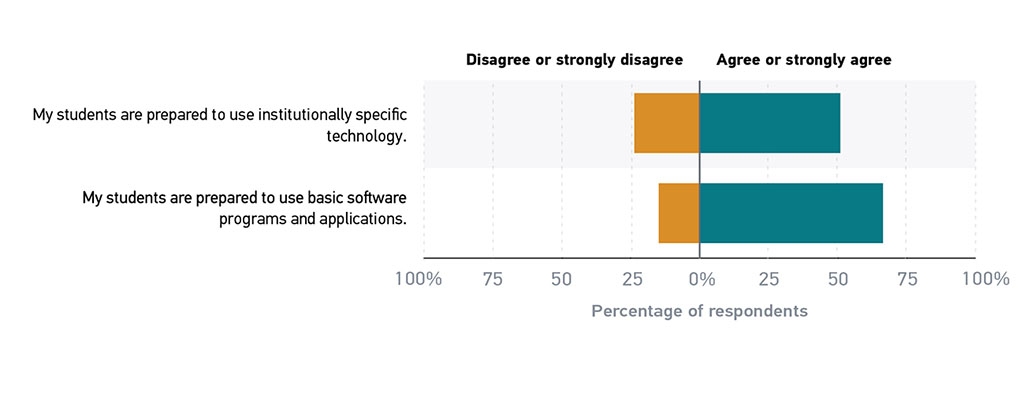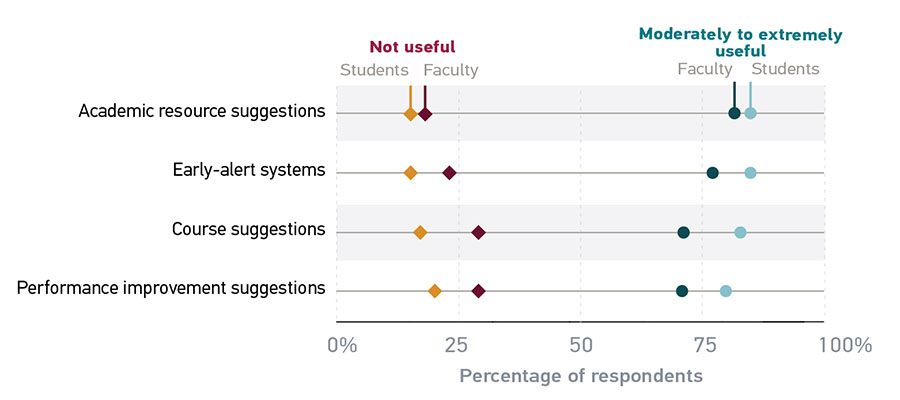What Faculty Think about Students and IT
Perceptions of Students' Technology Literacy
Smartphones are nearly ubiquitous among students, as are laptops, and a majority of students use smartphones in their courses. Indeed, fully 98% of students own two or more Internet-capable devices. While owning a device does not necessarily mean that one knows what to do with it, faculty by and large have confidence in their students’ technology literacy. Respondents were asked a small set of questions concerning their beliefs about their students’ preparedness to use technology necessary for course-related activities. Figure 6 shows that two-thirds agreed or strongly agreed that their students are prepared to use commercial software applications (e.g., MS Office, Google Apps).

On the other hand, only half of faculty agreed or strongly agreed that their students are prepared to use institutionally specific technology (e.g., the course registration system, the LMS). By comparison, fewer than half of students believe this of themselves. This could be interpreted as faculty succumbing, ironically, to “expert syndrome,” wherein faculty forget that not everyone knows what they know—in this case about how to use institutionally specific technology. Students, of course, and particularly new students, have not been at the institution long enough to gain the depth of experience that many faculty have with this technology.
Whatever the reasons for these beliefs, there is clearly a need for training to be offered to students in the use of both institutionally specific technology and commercial software. Whatever help students have received in using technology, it is not coming from their instructors, despite the fact that some faculty seem to think it is: 59% of faculty agreed or strongly agreed that their students look to them or their teaching assistants for technology support. However, only 25% of students said that they ask their instructors, and only 6% ask their teaching assistants, for technology support for school-related activities.1
Taken together, these findings indicate a clear need for the institution’s central IT unit or other appropriate unit on campus to offer such technology training to students. Many students, by their own admission, feel unprepared to use institutionally specific technology, and some even feel unprepared to use commercial software. Given that both categories of technology are critical to student success, this is a major point of failure for students. However, this is an area in which the institution can make significant inroads through a combination of identifying the most critical training needs among the student body at the institution and promoting training offerings to raise awareness and bring in those students most in need of them. Faculty, for their part, are critical to raising awareness of technology training on campus. By discussing these offerings in class, or better still by encouraging or even requiring students to attend training sessions, faculty have considerable power to improve student technology literacy.
Student Success Management Systems
Integrated planning and advising for student success (iPASS) tools were named one of the top strategic technologies by EDUCAUSE for the first time in 2017.2 Driven by mandates for student success initiatives and data-driven decision making, such student success management systems (SSMSs)3 are fully deployed at only a handful of institutions, but many institutions are beginning to track and learn about them. Implementation of SSMSs is not just an IT project—it is a student success project that requires buy-in from stakeholders across the institution including, but not limited to, advising, student affairs, registrar’s offices, institutional research, counseling, academic affairs, faculty, and, of course, students.
Students and faculty were asked a small set of similar questions about how useful they find a set of services that are common in student success management systems. This section compares and contrasts these responses.
The first thing to notice in figure 7 is that students evaluate the usefulness of all four SSMS services significantly higher than faculty do. The greatest difference between faculty and student ratings is for course suggestions, and it is perhaps unsurprising that students would find such a service more useful than faculty do.

What is not shown in figure 7 is the very large percentage of “Service not provided” and “Don’t use service” responses. Between 7% and 21% of students and between 16% and 28% of faculty do not have access to these services, while between 21% and 28% of students and between 23% and 34% of faculty have access but apparently choose not to use these services. The services that the greatest percentage of faculty choose not to use are course suggestions and performance improvement suggestions, services that might (if used) inform the faculty member’s advising. The service that faculty use the most is early-alert systems, which might inform the faculty member’s teaching.
The reason for such high rates of non-use of these SSMS services is unclear. If students and faculty know that a service is offered by an institution and have made a conscious decision not to use it, then this points to a serious problem with the implementation of these SSMS services. Why are students and faculty not using them when they have the potential to be so useful? Could it be that institutions did not secure the requisite buy-in from faculty and students when implementing these tools? Do these tools not provide the functionality users want? Are the user interfaces so poor (compared with those of Netflix, Amazon, and other common recommender systems) that users consider them unusable?4
Notes
-
D. Christopher Brooks and Jeffrey Pomerantz, ECAR Study of Undergraduate Students and Information Technology, 2017, research report (Louisville, CO: ECAR, October 2017). Some institutions are experimenting with innovative models of providing technology support to students. The University of Mary Washington’s Digital Knowledge Center, for example, provides a peer tutoring service to students—staffed by students.
↩︎ -
See Integrated Planning and Advising for Student Success (iPASS).
↩︎ -
Carl Straumsheim, “A New* System for Student Success Planning,” InsideHigherEd, July 5, 2017
↩︎ -
Jon Becker, “Nurturing Curiosity through Course Selection/Registration,” April 8, 2016; Gardner Campbell, “cri de cœur,” April 10, 2016.
↩︎